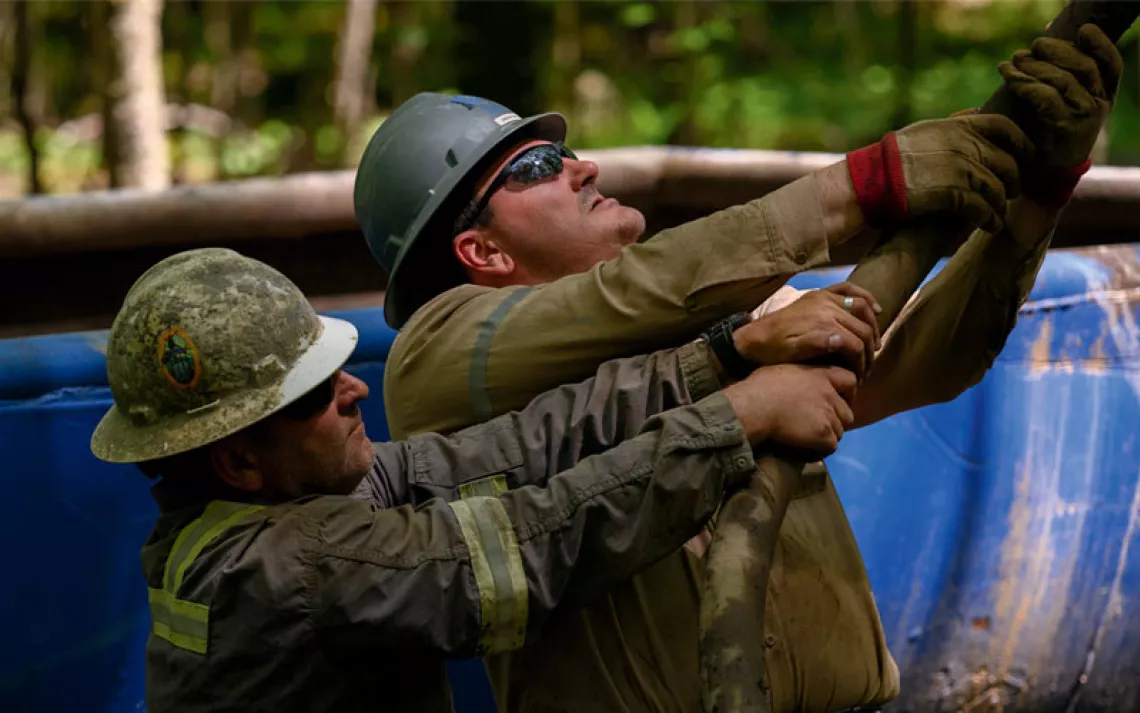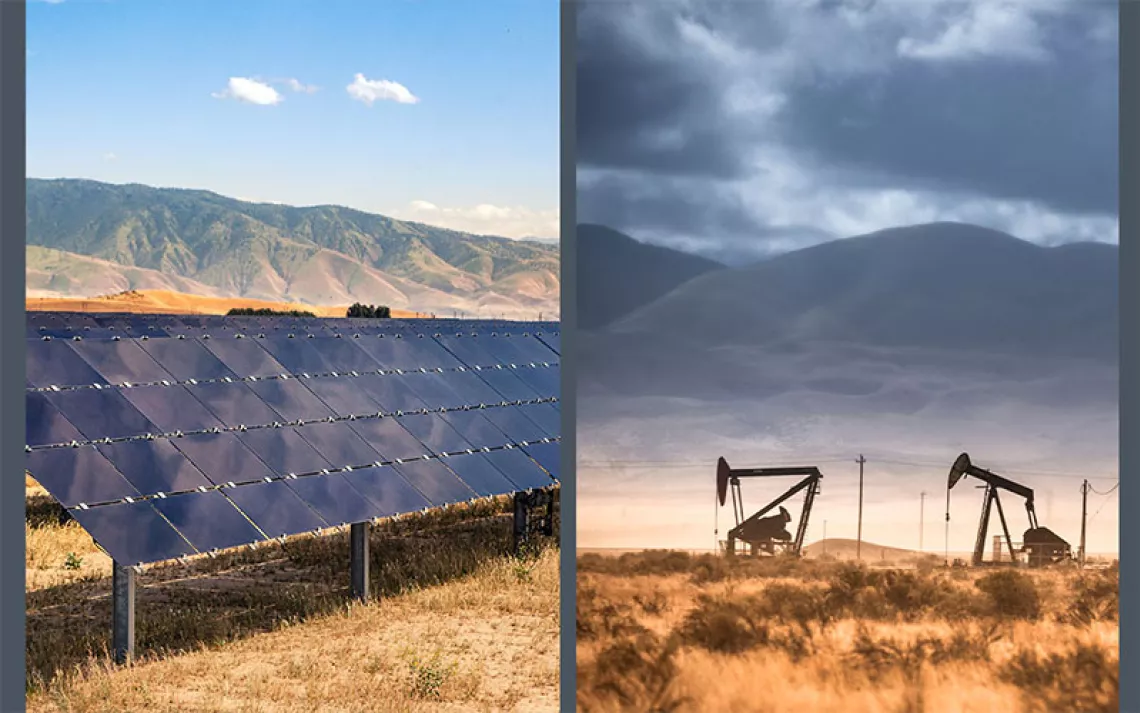Abandoned Oil and Gas Sites Are Leaking Methane Across the Country
Millions of inactive sites emit greenhouse gases without a plan to clean them up

Photo by AP Photo/Eric Gay
Twin beige tanks stand amid stately evergreens in Colorado’s Medicine Bow-Routt National Forest. Their only companion is a silent pump jack. The inactive oil and gas site not only mars the view; it is also leaking toxic gases known to accelerate climate change.
Video shot by an optical gas-imaging camera shows plumes of methane and volatile organic compounds venting into the atmosphere from valves on top of the tanks. The pad’s operator, unable to pay to clean it up, abandoned the site in 2019, leaving taxpayers to foot the bill.
“This venting will presumably occur until these sites are cleaned up,” said Andrew Klooster, Colorado field advocate for Earthworks, who filmed the site for the environmental nonprofit in June and reported his findings to state regulators.
“We have to sit here rather uncomfortably because sites like this will continue to pollute,” he added. “It’s a mess when it comes to orphaned wells, honestly.”
The site is among at least 137 wells in Rio Blanco County, on the state’s western slope, that haven’t produced fossil fuels in five years. They join 3.2 million wells nationwide abandoned by energy companies who weren’t required to post large-enough bonds to clean them up. Thousands more are undocumented or at risk of becoming orphaned.
State and federal agencies are now liable for much of this cost—which Carbon Tracker estimated could approach $280 billion to remediate 2.6 million documented onshore wells alone. States collected less than 1 percent of this amount in bonds, the study found, leaving hulking metal tanks and pump jacks to rust in corn fields, forests, and neighborhoods, where they present a health, safety, and climate hazard for people and wildlife.
Methane emissions from inactive oil and gas infrastructure are the 10th-largest source of such pollutants in the United States. The greenhouse gas is 25 times more potent than carbon dioxide at trapping heat in the atmosphere. In 2014, a gas leak from an abandoned well underneath an Ohio elementary school gym forced officials to evacuate students. In West Texas, near the town of Imperial, fluids leaking from decades-old oil wells formed a pond of contaminated water.
Now, Congress is poised to provide billions of dollars in funding to start plugging these wells as part of the Biden administration’s ambitious climate agenda. Legislators are also working to reform rules that require companies to post adequate bonds to clean up oil and gas sites once they’re finished extracting fossil fuels.
Conservationists hailed the measures as a rare opportunity to restructure how the federal government holds the oil and gas industry accountable for cleaning up energy infrastructure strewn across the country after more than 120 years of exploration.
“There’s every incentive financially right now for the industry to keep focusing on drilling more wells—they are not saving for the retirement of these wells,” said Kyle Tisdel, a senior attorney and climate and energy program director with the Western Environmental Law Center. “We have a very narrow margin in Congress right now. We need to seize this moment to preserve our planet.”
Provisions to plug inactive oil and gas wells are included in the $1.2 trillion bipartisan infrastructure package the Senate approved and forwarded to the House. The bill includes $4.7 billion for orphaned well cleanup on state, private, federal, and tribal lands. Orphaned wells are those where no known operator can be held responsible for cleaning up the site.
While these funds would be provided by taxpayers, legislators incorporated bonding reform into a $3.5 trillion Democratic reconciliation bill being drafted in the House to ensure companies pay for future remediation efforts. The measure would increase the bond amount an operator is required to post on a single federal lease from $10,000 to $150,000 and in a state from $25,000 to $500,000.
The proposal doesn’t account for wells on private and state land, where costs vary widely and are expected to mount as thousands of horizontal wells, drilled over the past two decades, approach the end of their useful life.
The Bureau of Land Management, which oversees energy exploration on public lands, hasn’t adjusted bonding levels in more than 50 years. The Government Accountability Office found in 2019 that “bonds held by the BLM are insufficient to prevent orphaned wells.”
Conservationists say that policy on abandoned oil and gas wells in both bills, expected to come up for a vote in the House in coming weeks, must remain intact to start reforming an energy regulatory system that is broken.
“These two issues need to advance together,” said Josh Axelrod, a senior policy advocate at the Natural Resources Defense Council. “Nationally, the number of orphaned and abandoned wells is so significant—and the amount of money needed is so massive—this is an impressive investment in the problem and brings the issue to the fore.”
The energy industry supports the abandoned oil and gas well provisions in the infrastructure package, said Jess Szymanski, spokesperson at the American Petroleum Institute. She didn’t respond to repeated email queries about the trade group’s position on bonding reform.
The broad reconciliation bill could be in jeopardy. Republicans universally oppose the legislation, and progressive and moderate Democrats disagree on how much spending is necessary. The stakes are high: The party’s margin in Congress is so narrow that it can afford only three House defections and none in the Senate, where Joe Manchin, of West Virginia and Arizona’s Kyrsten Sinema have said the proposed cost is too steep.
Democratic leaders have said the price tag may need to fall, angering progressives who assert they won’t support the infrastructure bill unless the reconciliation bill is approved at the same time. Various polls show support among voters—including independents and some Republicans—for both packages. The measure is colloquially called the reconciliation bill because Democrats hope to use the arcane budget process to pass the legislation in the Senate with a simple majority vote.
President Joe Biden called out the proposals to clean up abandoned oil and gas wells at a recent appearance at the National Renewable Energy Laboratory in Arvada, Colorado, as part of a speech touting his plans to tackle climate change.
“We’re going to cap thousands of abandoned oil wells and gas wells leaking methane, threatening public health in communities,” he said, after listing a litany of extreme events fueled by climate change that pummeled the West this summer including record drought, heat, and wildfires.
In Colorado, Earthworks’ Klooster filmed the inactive oil and gas infrastructure about 166 miles to the west of where Biden stood. The site is on public land and is the federal government’s responsibility to clean up, said Megan Castle, communications officer at the Colorado Oil & Gas Conservation Commission. A state inspector’s report from October 2020 found there were “no active leaks” from the tanks visible to the naked eye. But Klooster’s camera told a different story.
“These crude oil tanks are sitting just off a trailhead—they still have product in them—which is why they are allowed to vent for safety reasons,” said Klooster. “But there is not much oversight in terms of what might be venting.”
 The Magazine of The Sierra Club
The Magazine of The Sierra Club



